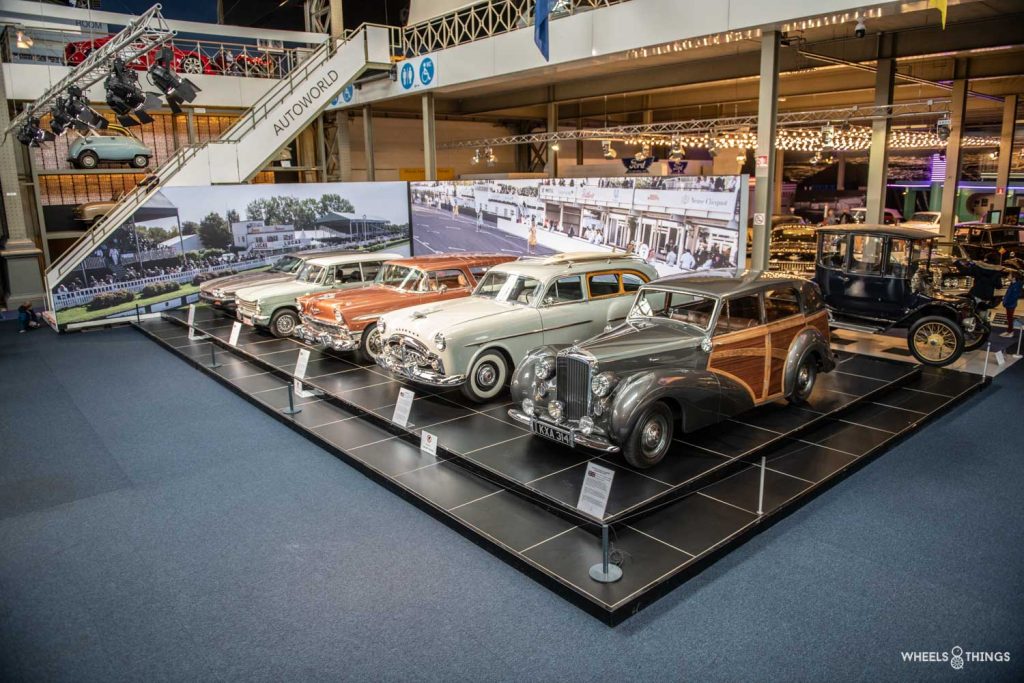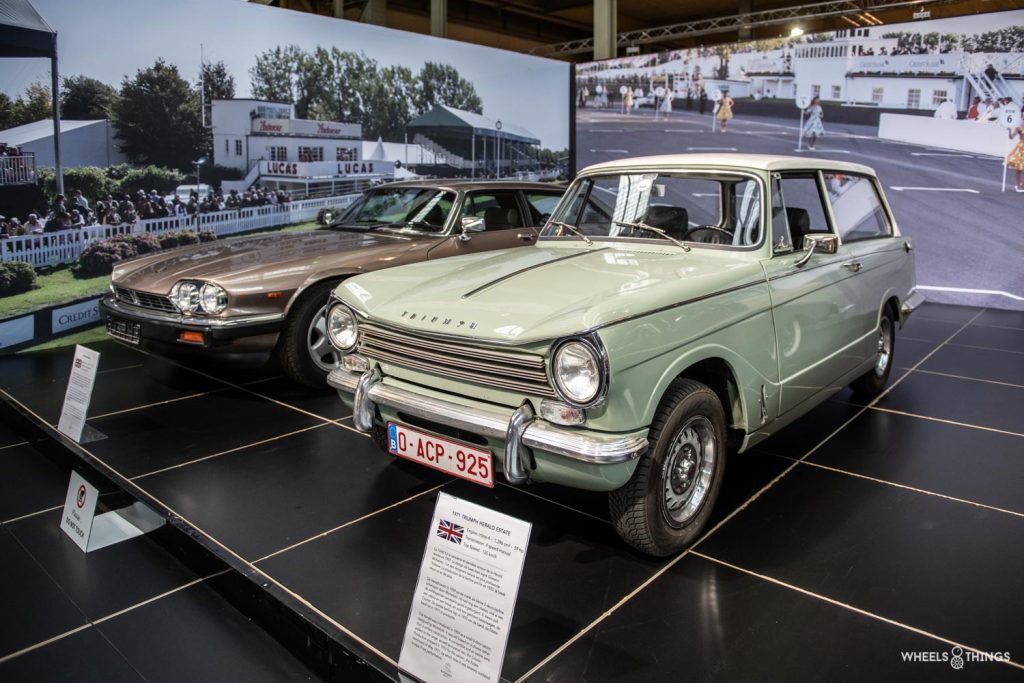
A bit of a special category, breaks & station wagons. But I didn’t want to let it pass. Perhaps it has something to do with the fact that I have been driving an estate car for years. And to me these are and remain very practical cars. Although fortunately a lot has changed in recent decades.
History
This type of car came over from the United States in the 1950s and 1960s, but they had been around for much longer. They were also sometimes called familly wagons.
The definition of the word station wagon could be described as follows. A car with a passenger compartment that extends to the back of the car. As a result, the car has almost no trunk but can carry up to nine people. The rear seats can be folded down to carry larger items. And a large tailgate is provided to make loading easier.
Woodie wagons (1910 – 1945)

The first station wagons were built around 1910. This was done by coach builders. One bought a chassis e.g. a Ford T and a coach builder built a wooden body on it. They were initially used near train stations to transport goods. They had a number of different names, I’ll just sum them up: Depot hacks, hackney carriage, carryalls and suburbans.
In 1923, ‘Star’ (a division of Durant Motors) was the first company to start assembling a complete car. The chassis was their own production and the wooden ‘coach’ they bought from an external coachbuilder. These wooden coachworks required a lot of maintenance. Of course the wood had to be maintained. But every so often all the bolts had to be tightened because the softness of the wood created slack.
Steel-Bodied station wagons (1945 – 1970)
The first completely steel station wagon was the Chevrolet Suburban, built in 1935. This set the trend and all manufacturers gradually switched to steel bodies. This was because of its durability, lower production cost and strength. By 1951, almost all station wagons were built entirely of steel.
Competition from the monovolume car (1970 – 1995)
From the 1970s onwards, the station wagon received competition from the emerging monovolumes. In the United States, it was mainly the Chrysler brands with their Voyager and Dodge with their Caravan that held sway. But the first would have been the Stout Scarab launched in 1934.

Here, Europe was also among the early birds. Fiat introduced their first Multipla in 1956. Based on a Fiat 600, this was quite a nice car but judge for yourself.
Later in 1984, the by everyone known Renault Espace followed. This French monovolume was the breakthrough for this type of car in Europe.
The monovolume makes way for the SUV (1990 – present)
Another shift, the monovolume is gradually making way for the much tougher looking SUV or rather Sport utility vehicle. Of course the first SUV existed long before 1990, take Land Rover for example with their Range Rover on which you can find more info in our earlier article. But it was still only around the 90’s that the general public fell for these types of cars. Until today they are still immensely popular although every user knows that they are not the most ecological cars. Well, being tough may cost something.
Back to the station wagon or break
Even though the station wagon has had a lot of competition, it has never been gone. And that makes sense because especially in the last 25 years, station wagons don’t just look good. They just drive as well as a sedan with just a lot more room.
Just about every self-respecting brand today has an estate car in its range. And the premium brands do not hesitate to put their heaviest engines in the front as well. You really don’t have to make an effort to find a station wagon with more than 600 hp. Just so you can drive to your golf club in style without having to lug that heavy golf bag around.
The exhibition

I was wandering a bit above so now back to the exhibit. This is a limited selection of about 15 cars. The selection dates mostly from the 50s and 60s and we find a mix of Americans and some European models. As we are used to from Autoworld, they have managed to bring in some unique pieces.
Packard

Let’s start with this 1941 Packard Deluxe One Twenty Woody. Packard was the preeminent American luxury brand. The One Twenty was their most popular model before the war. Packard did not build station wagons themselves, for this they went to specialists in this matter. This Packard has a bodywork by Hercules of Indiana. The car is unique and especially in this quasi perfect condition.

A second Packard can be found further into the exhibit. This is an all-steel 1952 Packard 200. This was the entry-level model with a short wheelbase and “least powerful” engine. It is an 8 in line with a cylinder capacity of 4730cc. The model on display is unique because it is based on the saloon of which it retained the striking rear window. According to the papers, it was originally a hearse.
Chrysler

special Chrysler is this 1955 New Yorker Town and Country Wagon. Perhaps one of the first station wagons where driving pleasure was also important. So this Chrysler got the famous Hemi V8 engine built in. The engine delivered 195 hp which made this station wagon 170km / h fast. There are only 750 built of which only 15 are known today. Fun fact is that this New Yorker then cost more than a Rolls-Royce.
Chevrolet

Let’s start with the Chevrolet Superior, I don’t think you can call it a real station wagon. Maybe a monovolume avant la lettre. But the remarkable thing is that this Chevrolet is the first built in the GM factory in Antwerp and this in 1925.

We take a jump to 1956 and end up with this Chevrolet Nomad. This sporty-looking three-door station wagon was a cross between a sports car and a station wagon. Perhaps it came a few decades too soon because it never became a real success. After barely three years, production was discontinued.
Ford

You might expect me to continue the line on American soil. But nothing could be further from the truth, Taunus was the general name for all German models of Ford Europe. This is a 1958 Ford Taunus P2 “Barock”. The P2 here stands for the second generation. Of this break model, there is only one known in Belgium.

For this 1956 Ford Country Sedan, we cross back over the pond. It was a mid-size break that borrowed many elements from the Ford Fairlane. In the version as it stands here, it accommodated nine people. There was also a Ranch Wagon and a Luxury version that bore the name Country Squire. This one was recognizable by the imitation wood panels on the flanks.
Citroën

Perhaps for many, one of the most well known cars in the entire collection. This 1974 ID20 Familiale lives up to its nickname “iron” even more. Underground parking with a car of this length is best avoided. The ID/DS models were built from 1955 to 1975 and there were very many variants built. A total of 93919 breaks were built and these are among the rarer Citroëns.
Bentley

I mentioned it before, even luxury brands are not averse to a break. So here we see a perfectly restored 1948 Bentley Mark VI Radford Countryman Estate. This is the first of 8 copies built. This was Harold Radford’s personal car, and to me personally one of the finest on display here.
Lynx / Jaguar

Let’s stay in England for a while longer. Here we see a Lynx Eventer, but you don’t have to be a connoisseur to recognize a Jaguar XJS. Lynx is a British coachbuilder that transformed this XJS into an attractive “shooting brake” Only 63 of them were built between 1983 and 2002. All were hand-built on special order.
Triumph

We close the list of Brits with this 1971 Triumph Herald Estate. That it’s not just big luxurious cars proves this Herald. The small two-door break was a derivative of the popular sedan. It turned out to be a compact handy car that was in production from 1959 to 1971. By the way, there was also a convertible version available and even a closed van.
Mercedes

We will finish with this Mercedes, no, not a German car. This car can definitely be called a Belgian Mercedes because it was built by I.M.A. in Mechelen. For the most part it was developed in Mechelen. It was a car for mixed use as it was called then. The car had a payload of no less than 710 kg. It was available with a four-cylinder petrol or diesel. The six-cylinder was only available in petrol. Between 1965 and 1968, 2754 of them were built.
Conclusion

Whether you should go to Autoworld just for this exhibition is not entirely clear to me. There are some really beautiful and unique pieces but you have to like the genre of course. For me it was worth a visit. And if you combine this exhibition with the rest of the cars on display, I will probably repeat that Autoworld deserves your visit.
Photos and report: Patrick Verheeken
